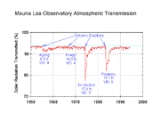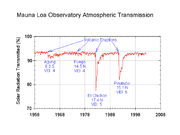
El Chichón
Encyclopedia
El Chichón, also known as El Chichonal (roughly translated in English as "The bump") is an active volcano
in Francisco León
Municipality in northwestern Chiapas
, Mexico
. Its only recorded eruptive activity was on March 29, April 3 and April 4, 1982 , when it produced a one km-wide caldera
that then filled with an acidic crater lake
. The eruption killed around 2,000 people who lived near the volcano. It had high-sulfur anhydrite-bearing magma, explosive eruptions, pyroclastic flow
s, and surges that were devastating.
In 2000, the lake's water temperature increased. Also, the lake acquired a blue-green color, due to massive amounts of dissolved minerals in the acidic water, and fine, light-colored ashy sediment continually stirred up by boiling areas.
El Chichon is part of a geologic zone known as the Chiapanecan Volcanic Arc. This volcanic region is thought to be the result of the subduction of the Tehuantepec Ridge
, an undersea ridge which lies on the Cocos Plate
off the Pacific coast of Mexico.
Volcano
2. Bedrock3. Conduit 4. Base5. Sill6. Dike7. Layers of ash emitted by the volcano8. Flank| 9. Layers of lava emitted by the volcano10. Throat11. Parasitic cone12. Lava flow13. Vent14. Crater15...
in Francisco León
Francisco León
Francisco León is a town and one of the 119 Municipalities of Chiapas, in southern Mexico.As of 2005, the municipality had a total population of 5,236. It covers an area of 114.3 km²....
Municipality in northwestern Chiapas
Chiapas
Chiapas officially Estado Libre y Soberano de Chiapas is one of the 31 states that, with the Federal District, comprise the 32 Federal Entities of Mexico. It is divided in 118 municipalities and its capital city is Tuxtla Gutierrez. Other important cites in Chiapas include San Cristóbal de las...
, Mexico
Mexico
The United Mexican States , commonly known as Mexico , is a federal constitutional republic in North America. It is bordered on the north by the United States; on the south and west by the Pacific Ocean; on the southeast by Guatemala, Belize, and the Caribbean Sea; and on the east by the Gulf of...
. Its only recorded eruptive activity was on March 29, April 3 and April 4, 1982 , when it produced a one km-wide caldera
Caldera
A caldera is a cauldron-like volcanic feature usually formed by the collapse of land following a volcanic eruption, such as the one at Yellowstone National Park in the US. They are sometimes confused with volcanic craters...
that then filled with an acidic crater lake
Crater lake
A crater lake is a lake that forms in a volcanic crater or caldera, such as a maar; less commonly and with lower association to the term a lake may form in an impact crater caused by a meteorite. Sometimes lakes which form inside calderas are called caldera lakes, but often this distinction is not...
. The eruption killed around 2,000 people who lived near the volcano. It had high-sulfur anhydrite-bearing magma, explosive eruptions, pyroclastic flow
Pyroclastic flow
A pyroclastic flow is a fast-moving current of superheated gas and rock , which reaches speeds moving away from a volcano of up to 700 km/h . The flows normally hug the ground and travel downhill, or spread laterally under gravity...
s, and surges that were devastating.
In 2000, the lake's water temperature increased. Also, the lake acquired a blue-green color, due to massive amounts of dissolved minerals in the acidic water, and fine, light-colored ashy sediment continually stirred up by boiling areas.
El Chichon is part of a geologic zone known as the Chiapanecan Volcanic Arc. This volcanic region is thought to be the result of the subduction of the Tehuantepec Ridge
Tehuantepec Ridge
The Tehuantepec Ridge is a linear undersea ridge located off the west coast of Mexico in the Pacific Ocean. It is the remnant of an old fracture zone, and not a tectonic spreading center ridge . It extends from the eastern end of the Clipperton Fracture Zone northeastward toward Mexico until it...
, an undersea ridge which lies on the Cocos Plate
Cocos Plate
The Cocos Plate is an oceanic tectonic plate beneath the Pacific Ocean off the west coast of Central America, named for Cocos Island, which rides upon it.-Geology:...
off the Pacific coast of Mexico.
Gallery
 |

